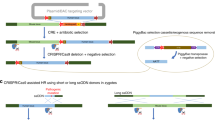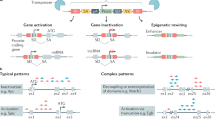Abstract
It is now evident that differences in the DNA sequence of genes involved with drug action can lead to interindividual differences in effectiveness and adverse reactions to therapeutic drugs. Pharmacogenomics raises the possibility that drug discovery and patient management could move from a 'one drug fits all' approach to one in which therapy is tailored to patients' genomes. Genetically modified mice that mimic human variation in drug response can provide one of the tools to move the field towards these goals.
This is a preview of subscription content, access via your institution
Access options
Subscribe to this journal
Receive 12 print issues and online access
$189.00 per year
only $15.75 per issue
Buy this article
- Purchase on Springer Link
- Instant access to full article PDF
Prices may be subject to local taxes which are calculated during checkout


Similar content being viewed by others
References
Weinshilboum, R. Inheritance and drug response. N. Engl. J. Med. 348, 529–537 (2003).
Goldstein, D. B., Tate, S. K. & Sisodiya, S. M. Pharmacogenetics goes genomic. Nature Rev. Genet. 4, 937–947 (2003).
Morello, J. P. & Bichet, D. G. Nephrogenic diabetes insipidus. Annu. Rev. Physiol. 63, 607–630 (2001).
Green, S. A., Cole, G., Jacinto, M., Innis, M. & Liggett, S. B. A polymorphism of the human β2-adrenergic receptor within the fourth transmembrane domain alters ligand binding and functional properties of the receptor. J. Biol. Chem. 268, 23116–23121 (1993).
Small, K. M., Forbes, S. L., Rahman, F. F., Bridges, K. M. & Liggett, S. B. A four amino acid deletion polymorphism in the third intracellular loop of the human α2C-adrenergic receptor confers impaired coupling to multiple effectors. J. Biol. Chem. 275, 23059–23064 (2000).
Vuchetich, J. P., Weinshilboum, R. M. & Price, R. A. Segregation analysis of human red blood cell thiopurine methyltransferase activity. Genet. Epidemiol. 12, 1–11 (1995).
Krynetski, E. Y. et al. A single point mutation leading to loss of catalytic activity in human thiopurine S-methyltransferase. Proc. Natl Acad. Sci. USA 92, 949–953 (1995).
Green, S. A., Turki, J., Bejarano, P., Hall, I. P. & Liggett, S. B. Influence of β2-adrenergic receptor genotypes on signal transduction in human airway smooth muscle cells. Am. J. Resp. Cell Mol. Biol. 13, 25–33 (1995).
Grubb, B. R. & Boucher, R. C. Pathophysiology of gene-targeted mouse models for cystic fibrosis. Physiol. Rev. 79, S193–S214 (1999).
Hew, K. W. & Keller, K. A. Postnatal anatomical and functional development of the heart: a species comparison. Birth Defects Res. Part B Dev. Reprod. Toxicol. 68, 309–320 (2003).
Vikstrom, K. L. et al. The vertebrate myosin heavy chain: genetics and assembly properties. Cell Struct. Funct. 22, 123–129 (1997).
Subramaniam, W. et al. Tissue-specific regulation of the α-myosin heavy chain gene promoter in transgenic mice. J. Biol. Chem. 266, 24613–24620 (1991).
Korfhagen, T. R. et al. Cis-acting sequences from a human surfactant protein gene confer pulmonary-specific gene expression in transgenic mice. Proc. Natl Acad. Sci. USA 87, 6122–6126 (1990).
Gonzalez, F. J. Role of gene knockout and transgenic mice in the study of xenobiotic metabolism. Drug Metab. Rev. 35, 319–335 (2003).
Zaher, H. et al. Protection against acetaminophen toxicity in CYP1A2 and CYP2E1 double-null mice. Toxicol. Appl. Pharmacol. 152, 193–199 (1998).
Gonzalez, F. J. & Kimura, S. Study of P450 function using gene knockout and transgenic mice. Arch. Biochem. Biophys. 409, 153–158 (2003).
Corchero, J. et al. The CYP2D6 humanized mouse: effect of the human CYP2D6 transgene and HNF4α on the disposition of debrisoquine in the mouse. Mol. Pharmacol. 60, 1260–1267 (2001).
Granvil, C. P. et al. Expression of the human CYP3A4 gene in the small intestine of transgenic mice: in vitro metabolism and pharmacokinetics of midazolam. Drug Metab. Dispos. 31, 548–558 (2003).
Ingelman-Sundberg, M., Oscarson, M. & McLellan, R. A. Polymorphic human cytochrome P450 enzymes: an opportunity for individualized drug treatment. Trends Pharmacol. Sci. 20, 342–349 (1999).
Pirmohamed, M. & Park, B. K. Cytochrome P450 enzyme polymorphisms and adverse drug reactions. Toxicology 192, 23–32 (2003).
Crespi, C. L. et al. Comparison of substrate metabolism by wild type CYP2D6 protein and a variant containing methionine, not valine, at position 374. Pharmacogenetics 5, 234–243 (1995).
Turki, J. et al. Myocardial signalling defects and impaired cardiac function of a human β2-adrenergic receptor polymorphism expressed in transgenic mice. Proc. Natl Acad. Sci. USA 93, 10483–10488 (1996).
Perez, J. M. et al. β1-adrenergic receptor polymorphisms confer differential function and predisposition to heart failure. Nature Med. 9, 1300–1305 (2003).
Huang, W. Y., Aramburu, J., Douglas, P. S. & Izumo, S. Transgenic expression of green fluorescence protein can cause dilated cardiomyopathy. Nature Med. 6, 482–483 (2000).
Nebert, D. W., Dalton, T. P., Stuart, G. W. & Carvan, M. J. III. 'Gene-swap knock-in' cassette in mice to study allelic differences in human genes. Ann. NY Acad. Sci. 919, 148–170 (2000).
Prows, D. R., Shertzer, H. G., Daly, M. J., Sidman, C. L. & Leikauf, G. D. Genetic analysis of ozone-induced acute lung injury in sensitive and resistant strains of mice. Nature Genet. 17, 471–474 (1997).
Dalton, T. P. et al. Refining the mouse chromosomal location of Cdm, the major gene associated with susceptibility to cadmium-induced testicular necrosis. Pharmacogenetics 10, 141–151 (2000).
Casley, W. L., Menzies, J. A., Whitehouse, L. W. & Moon, T. W. Detection of quantitative trait loci affecting caffeine metabolism by interval mapping in a genome-wide scan of C3H/HeJ x APN F2 mice. Drug Metab. Dispos. 27, 1375–1380 (1999).
Jones, B. C. et al. Quantitative-trait loci analysis of cocaine-related behaviours and neurochemistry. Pharmacogenetics 9, 607–617 (1999).
Port, J. D. & Bristow, M. R. Altered β-adrenergic receptor gene regulation and signaling in chronic heart failure. J. Mol. Cell Cardiol. 33, 887–905 (2001).
van Campen, L. C., Visser, F. C. & Visser, C. A. Ejection fraction improvement by β-blocker treatment in patients with heart failure: an analysis of studies published in the literature. J. Cardiovasc. Pharmacol. 32 Suppl. 1, S31–S35 (1998).
Mason, D. A., Moore, J. D., Green, S. A. & Liggett, S. B. A gain-of-function polymorphism in a G-protein coupling domain of the human β1-adrenergic receptor. J. Biol. Chem. 274, 12670–12674 (1999).
Acknowledgements
Supported by National Institutes of Health grants.
Author information
Authors and Affiliations
Ethics declarations
Competing interests
The author declares no competing financial interests.
Glossary
- ACETAMINOPHEN
-
A non-prescription drug that is used to reduce fever and pain. Increased blood levels from overdose or altered metabolism can cause liver disease.
- BRONCHOSCOPY
-
A procedure in which a cylindrical fiberoptic scope is inserted into the airways. This scope contains a viewing device that allows the visual examination of the airways and channels for specimen retrieval.
- CARDIAC EJECTION FRACTION
-
The portion of blood that is pumped out of a filled ventricle as a result of a contraction.
- CARDIOMYOCYTES
-
Heart muscle cells.
- CATECHOLAMINES
-
The endogenous agonists (adrenaline and noradrenaline) for adrenergic receptors, which act as neurotransmitters and hormones.
- CYTOCHROME P450
-
A family of enzymes that act in various metabolic pathways, including inactivation of toxins. In addition, these enzymes can metabolize therapeutic drugs that affect activity and clearance.
- DEBRISOQUINE
-
An antihypertensive agent that is used as a benchmark agent in cytochrome P450 drug metabolism studies.
- DILATED CARDIOMYOPATHY
-
A disease of the heart that is characterized by dilated cardiac chambers and decreased pumping function. This is one of the most common forms of congestive heart failure.
- EXTENSIVE METABOLIZERS
-
An individual who metabolizes a substance at an accelerated rate or extent as compared with that of a reference population.
- LINKAGE DISEQUILIBRIUM
-
The occurence together on the same chromosome of specific alleles at closely linked loci more frequently than would be expected by chance.
- MIDAZOLAM
-
A drug that is used to promote sleepiness and reduce anxiety. It is also used as a benchmark agent in cytochrome P450 drug metabolism studies.
- NEPHROGENIC DIABETES INSIPIDUS
-
A congenital condition that is characterized by the passage of large volumes of urine owing to a defect of the kidney tubules.
- POLYMORPHISM
-
A variation in DNA sequence that occurs at an allele frequency ≥ 1% in a population. In this definition, the 1% value is arbitrary but well accepted. The nature of the variation, or whether it causes a disease, is not implied.
- PSEUDOPREGNANT FEMALES
-
Females that are mated with vasectomized males. These mice can maintain eggs transferred to them without uterine competition from naturally ovulated eggs.
- TACHYPHYLAXIS
-
A waning of the effects produced by a medication when used on a continuous basis.
- TAG-AND-EXCHANGE
-
A method by which a segment of mouse DNA is removed and replaced by another segment of DNA, such as a mutated form of the mouse segment or a human analogue. The DNA of interest is 'tagged' by selectable markers in a round of gene targeting to isolate the stem cells that have been so altered and to achieve specificity for the replacement.
- XENOBIOTICS
-
Foreign compounds that are taken up by the body. These include natural substances, therapeutic drugs and environmental toxins.
Rights and permissions
About this article
Cite this article
Liggett, S. Genetically modified mouse models for pharmacogenomic research. Nat Rev Genet 5, 657–663 (2004). https://doi.org/10.1038/nrg1429
Issue Date:
DOI: https://doi.org/10.1038/nrg1429
This article is cited by
-
Establishment of an integrated automated embryonic manipulation system for producing genetically modified mice
Scientific Reports (2021)
-
Genomics, heart failure and sudden cardiac death
Heart Failure Reviews (2010)
-
Genetically modified mouse models in cancer studies
Clinical and Translational Oncology (2008)



